| |

Traditions, folklore, history and more. If it's Irish, it's here. Or will be!
"People will not look forward to posterity who never look backward to their ancestors."
-Edmund Burke




Quotes
Library: Books, Movies, Music
Prints & Photos
Poetry
Jokes


Shops Ireland
Bunús na Gaeilge
(Basic Irish)
Circle of Prayer
Blessings
Did You Know?
Himself/Herself
Write to Us
Readers Write..
Links/Link to Us
Advertise with us
Awards & Testimonials
Submissions Guide

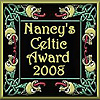
|
|
|
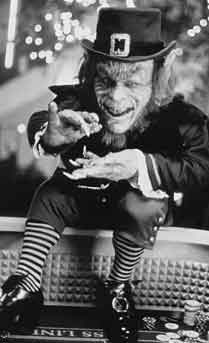 Creepy Irish Creatures Creepy Irish Creatures
by Bridget Haggerty
The lore of supernatural beings in Ireland is unlike that of the rest of Europe in one very important respect: spirit powers in the Emerald Isle have been endowed with names and personalities.
Of all the unearthly phenomena associated with Erin, two of the most famous are the Leprechaun and the Banshee. Always solitary, it is erroneous to ever consider a company of Leprechauns, or a group of Banshees. However, according to folklore, the Leprechaun was once part of a community called "Luchor-pan or the wee bodies. Over time, the name became corrupted and this corruption gave rise to the notion that "brog " or shoe was part of the name. Thus, Leprechauns became shoemakers to the Good People, as well as the protector of their treasures. And, for whatever reason, Leprechauns were identified with some very anti-social personality traits, including irascibility, cunning, doubletalk and a liking for their own company.
In Co. Kildare, the name "Lurikeen" appears to be the name for Leprechaun and there are still other monikers elsewhere, but throughout the country, the folklore is the same when it comes to his haunts, habits and hidden crocks of gold. If you should wish to seek one out, they're usually found near very old castles, and they're always engaged in making shoes, but always one - never a pair.
As the story goes, if you find one of these crafty rascals, you should draw close to him without making a sound and quickly take him in your grasp. Demand to know where the crocks of gold are hidden and beware of any distraction, for he will surely cheat you. Take your eyes from him for just an instant and he will disappear. The Far Darrig - "The Red Man" - is a near relation to the Leprechaun, but he dresses in red from head to toe and, much amused by mortal terror, he's been known to give his victims terrifying nightmares.
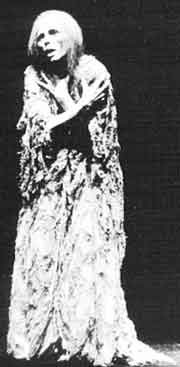 The Bean Sidhe or Banshee makes her appearance when someone in the household is about to die. She haunts only the families of the "high Milesian race" - those whose names have an "O", "Mac" or other prefix. One exception to this rule has been granted by virtue of the Irish poets who have given her to some of the Norman-Irish families - the FitzGerald's for example. In any event, she heralds the demise of only those who are of authentic noble stock and it is with great dread when her piercing "caoine" or keening is heard. In many respects, this mysterious creature resembles traditional Irish keeners or mourners of old; as with her mortal counterparts, those who have seen her describe her as drawing a comb through her hair, similar to tearing the hair out in anguish, which the ancient mourners used to do. Incidentally, or maybe not, while the Banshee is considered benign, she supposedly has a sister force who isn't; this force is called the Lianhan Sidhe and her sole purpose is to seek the love of mortal men. Their desire for her ultimately destroys them. The Bean Sidhe or Banshee makes her appearance when someone in the household is about to die. She haunts only the families of the "high Milesian race" - those whose names have an "O", "Mac" or other prefix. One exception to this rule has been granted by virtue of the Irish poets who have given her to some of the Norman-Irish families - the FitzGerald's for example. In any event, she heralds the demise of only those who are of authentic noble stock and it is with great dread when her piercing "caoine" or keening is heard. In many respects, this mysterious creature resembles traditional Irish keeners or mourners of old; as with her mortal counterparts, those who have seen her describe her as drawing a comb through her hair, similar to tearing the hair out in anguish, which the ancient mourners used to do. Incidentally, or maybe not, while the Banshee is considered benign, she supposedly has a sister force who isn't; this force is called the Lianhan Sidhe and her sole purpose is to seek the love of mortal men. Their desire for her ultimately destroys them.
 The Púca, pronounced "Pookah" is the Irish word for hobgoblin. One of the most feared spirits, according to legend, it can take on a variety of shapes and sizes in order to wreak havoc and harm. However, as the legend goes, it's now less dangerous thanks to the legendary King, Brian Boru, who is said to have tamed it and ridden it like a horse. In fact, (if one can use that word in the same sentence as talking about the supernatural), it's said that the Púca often takes on the form of a horse or calf, rushes between a victim's legs, and hoists them away for a mad dash across the countryside.
The Púca, pronounced "Pookah" is the Irish word for hobgoblin. One of the most feared spirits, according to legend, it can take on a variety of shapes and sizes in order to wreak havoc and harm. However, as the legend goes, it's now less dangerous thanks to the legendary King, Brian Boru, who is said to have tamed it and ridden it like a horse. In fact, (if one can use that word in the same sentence as talking about the supernatural), it's said that the Púca often takes on the form of a horse or calf, rushes between a victim's legs, and hoists them away for a mad dash across the countryside.
Besides horses and cows, the Púca can also take on the shape of a bird or bat and has been known to scratch the face of its quarry. Usually, this ominous spirit lies in wait at suitably eerie places such as a crossroads, fence or bridge.
The Taisé is the image of a person who is not present and warns of an imminent accident. The worst omen of all is to see the Taisé of yourself, which means you are about to die.
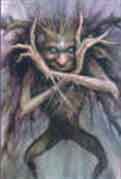 The Gray Man or Far Liath appears as a fog and covers land and sea with his mantle. He obscures rocks so ships crash upon them and darkens the road so that travelers unwittingly stumble over cliffs to their deaths. The Gray Man or Far Liath appears as a fog and covers land and sea with his mantle. He obscures rocks so ships crash upon them and darkens the road so that travelers unwittingly stumble over cliffs to their deaths.
The Grogoch was originally a half human, half-spirit entity who originated in Scotland and settled in Ireland. Well-known throughout north Antrim, Rathlin Island and parts of Donegal, he may also be found on the Isle of Man. He has the power of invisibility but will often allow certain trusted people to observe him. A very sociable being, he may even attach himself to certain individuals and help them with their planting and harvesting or with domestic chores, all for no payment other than a jug of cream. As with many supernatural beings, he has a great fear of the clergy and will not enter a house if a priest or minister is present.
The Dark Man or Far Dorocha rides on his black horse into our world to abduct humans that the Queen of the Good People desires. Although he never speaks, mortals invariably understand his commands and, unable to disobey, surrender their wills to his and mount up behind him.
The Demon Bride, a beautiful but evil spirit, seduces her mortal victim with a kiss that steals his soul. He dies the death of a raving lunatic, haunted by the knowledge of his fatal mistake.
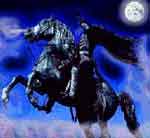 The Dullahan is a headless horseman who rides an equally headless horse during the dead of night; wherever he stops a mortal dies. We've devoted an entire article to this unholy terror which you can read here: The Dullahan. The Dullahan is a headless horseman who rides an equally headless horse during the dead of night; wherever he stops a mortal dies. We've devoted an entire article to this unholy terror which you can read here: The Dullahan.
The Dearg-Dur is Ireland's legendary vampire. According to some tales, it can take the shape of a pale young woman who lingers in graveyards at night waiting for unwary passers-by. Her beauty is irresistibly seductive, but when she kisses, she feeds on blood, draining the life from her victim. Supposedly, it can be defeated by building a cairn of stones over its grave.
Changelings were the replacement for a mortal child who had been stolen by the Good People. For fear that a handsome baby would be kidnapped, people wouldn't mention its beauty. For his or her protection, they would not only call God's blessing upon the baby but actually spit at it, hoping that this would deceive the Good People into believing the baby wasn't worth stealing. Interestingly, boy babies were often dressed like females in their first years to deceive the Good People who were always looking for a mate for their queen. In folklore, changelings were very ugly and had a voracious appetite, eating everybody around them out of house and home. Adults too, were sometimes kidnapped and the changeling would be recognized by its harsh voice and mean-spirited personality.
The Amadán or amadawn is the fool or jester in the court of the Good People. In the month of June, he supposedly escapes from the court to roam the countryside. it was once believed that the touch of the amadán would drive a person mad and cause them to be "touched."
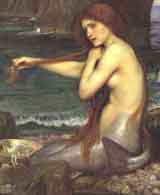 Merrows are the female inhabitants of Tir fo Thoinn - the Land beneath the Waves. The word merrow or moruadh comes from the Irish muir meaning sea and oigh meaning maid. According to folklore, they have special clothing which enables them to travel through ocean currents. In Kerry, Cork and Wexford, they wear a small red cap made from feathers, called a cohullen druith. In more northerly waters they travel through the sea wrapped in sealskin cloaks, taking on the appearance and attributes of seals. In order to come ashore, the Merrow abandons her cap or cloak, so any mortal who finds them has power over her, as she cannot return to the sea until they are retrieved. In some parts of Ireland, Merrows are regarded as messengers of doom and death. To learn more about Irish mermaids - also known as Selkies - read our children's story, here: The Selkie. Merrows are the female inhabitants of Tir fo Thoinn - the Land beneath the Waves. The word merrow or moruadh comes from the Irish muir meaning sea and oigh meaning maid. According to folklore, they have special clothing which enables them to travel through ocean currents. In Kerry, Cork and Wexford, they wear a small red cap made from feathers, called a cohullen druith. In more northerly waters they travel through the sea wrapped in sealskin cloaks, taking on the appearance and attributes of seals. In order to come ashore, the Merrow abandons her cap or cloak, so any mortal who finds them has power over her, as she cannot return to the sea until they are retrieved. In some parts of Ireland, Merrows are regarded as messengers of doom and death. To learn more about Irish mermaids - also known as Selkies - read our children's story, here: The Selkie.
There are undoubtedly a good many other creepy Irish creatures we haven't mentioned, but we'll end this brief look at the country's better-known ones with a few words on the origin of most of them.
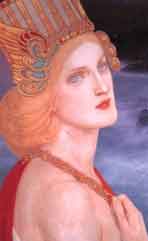 "The Good People" are thought to have evolved from the Tuatha Dé Danann, the Irish race of gods, founded by the goddess Danu. Irish mythology recounts a number of successive invasions where ultimately, the Milesians forced the Tuatha Dé Danann underground to forevermore dwell beneath the earth. These vanquished subjects of Danu were said to be equipped with supernatural powers and Irish folklore is filled with tales of them seeking vengeance by tormenting those who dwell above the ground. While the late Donnchadh Shéamais Ó Drisceoil, a man of great knowledge and intellectual abilities called it all 'rubbish', he is quoted as saying 'By God, I wouldn't like to walk through a lonely glen on a wild and stormy moonless night.'
"The Good People" are thought to have evolved from the Tuatha Dé Danann, the Irish race of gods, founded by the goddess Danu. Irish mythology recounts a number of successive invasions where ultimately, the Milesians forced the Tuatha Dé Danann underground to forevermore dwell beneath the earth. These vanquished subjects of Danu were said to be equipped with supernatural powers and Irish folklore is filled with tales of them seeking vengeance by tormenting those who dwell above the ground. While the late Donnchadh Shéamais Ó Drisceoil, a man of great knowledge and intellectual abilities called it all 'rubbish', he is quoted as saying 'By God, I wouldn't like to walk through a lonely glen on a wild and stormy moonless night.'
Irish folklore abounds with clever ways to defend oneself from the wrath of the Good People. For instance, folks who were out and about at night would bring along a piece of glowing coal or turf stuck on a stake or a fork. If they were attacked, they would thrust the burning weapon towards the spirit's mouth. This would usually stop the attack, but people would also bring lanterns in case the wind and rain extinguished the flames. These lanterns were meant purely as a defence against supernatural beings and not intended to light the way.
Fleeing into a graveyard or jumping across a creek were other options as it was believed the Good People couldn't follow you into a graveyard or across water. Religious folk, aware of the nightly danger, would also put their trust in holy water. It was transported in a handful of twisted stalks of straw, about six inches long, which had been dipped into the consecrated water. This "deisréad"* was carried in one hand, the arm stretched out in front of the carrier. Donnchadh Shéamais knew a woman who wouldn't dream of going out at night without a 'deisréad', or even more than one, although she claimed not to believe in the supernatural.
*pronounced desh-raid
Resources
Content:
Things Irish - Anthony Bluett
The Vanishing People: Fairy Lore and Legends - Katherine Briggs
Gael Talk
Ancient Legends, Mystic Charms and Superstitions of Ireland - Lady Wilde
Ireland's Eye - This is a great site for Ireland's supernatural residents - don't miss it!
See our other articles on Samhain and Halloween below:
An Irish Hallowe'en - Part 1
An Irish Hallowe'en - Part 2
How the Irish Invented Halloween
A Triple Treat For Hallowe'en
The Churchyard Bride
Creepy Irish Castles and Houses
Creepy Irish Creatures
Irish Ghosts
Something Wicked this way comes - Irish Ghosts by Region
Protect your property and yourself - Make a Parshell Cross for Hallowe'en
The Dullahan
Samhain - The Irish New Year
The Day after Samhain - All Souls Day
|
|
Fri, Sep 27, 2024
 The Galway Hooker The Galway Hooker
This unique vessel, with its distinctive curved lines and bright red sails, originated in the village of Claddagh. During the 19th century, hookers supported a significant fishing industry and also carried goods, livestock and fuel. Seán Rainey is remembered for building the last of the original boats, the Truelight, for Martin Oliver who was to become the last king of the Claddagh; as king, he was entitled to white sails on his boat. Since the mid seventies, many of the old sailing craft which were on the verge of extinction have been lovingly restored and new ones have been built. During the summer months they can be seen at festivals such a Cruinniú na mBád - the Gathering of the Boats - in Kinvara.
Click for More Culture Corner.
One of our favorite resources. A must-have if you want to learn the basics about Irish culture.
Click here for Things Irish.
|
|
|
|
|




 The Galway Hooker
The Galway Hooker